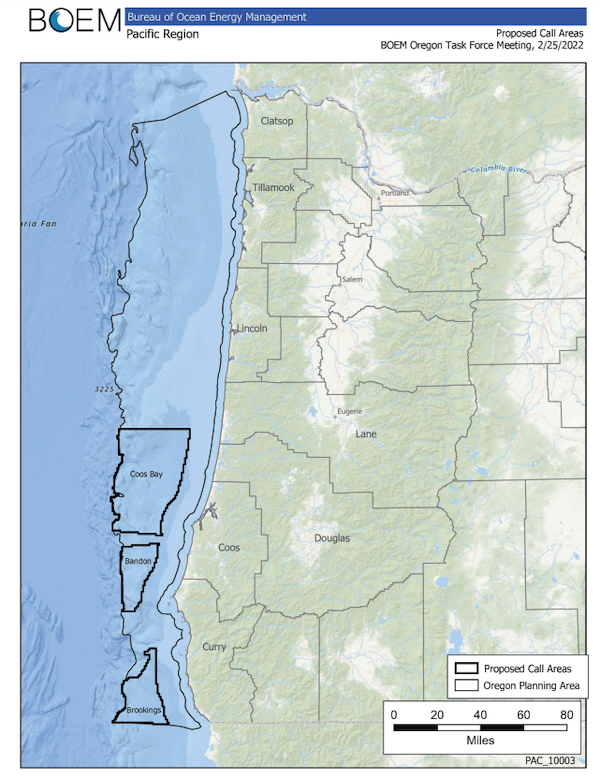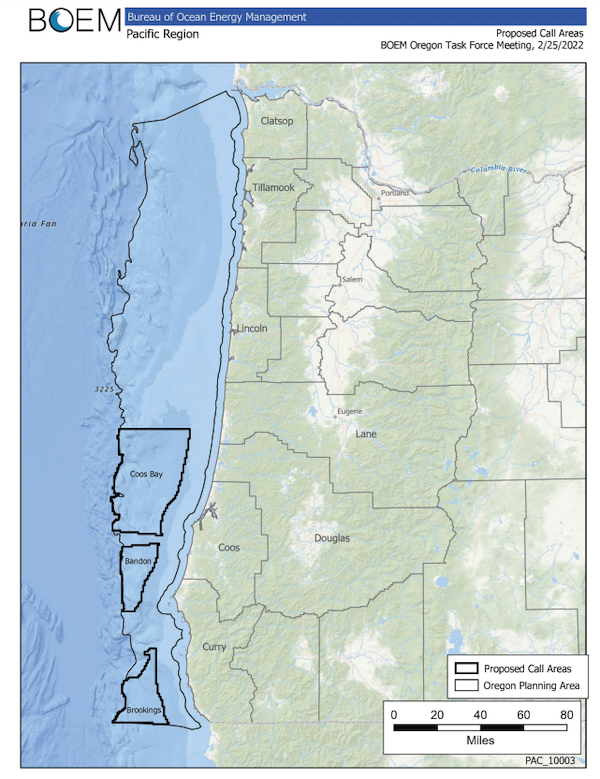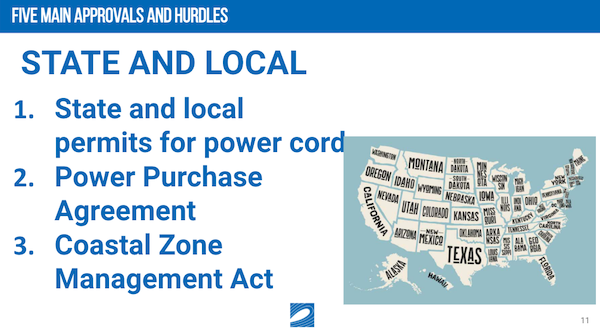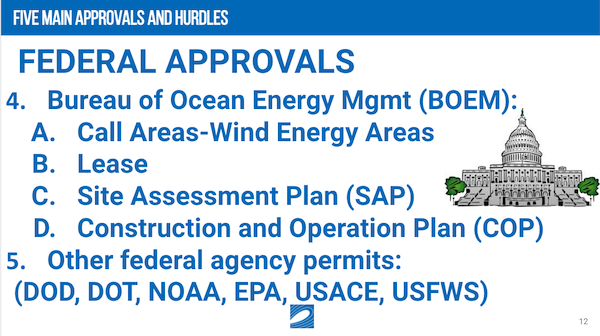
Today, the Bureau of Ocean Energy Management (BOEM) released the federal agency's proposed "Call Areas" deemed appropriate for offshore wind leasing. From wildlife and conservation advocates to existing ocean users, the three areas identified along Oregon's southern coast have elicited more than a vocal response of concern and some criticism for a lack of transparency in the federal process for informing the specific Call Areas identified. Tomorrow, Oregon's Task Force for BOEM will meet to help clarify and explain the areas identified and hear from the public on the proposed Call Areas and the next steps in this process - here's what we think they are going to hear and a little more on how Surfrider is approaching this process in Oregon.
 Proposed Call Areas off of Oregon's coast for wind energy development and the federal planning. Source: BOEM, download more
maps and charts here.
Proposed Call Areas off of Oregon's coast for wind energy development and the federal planning. Source: BOEM, download more
maps and charts here.
In some fairness to BOEM, there is really no good way to put lines on the map in Oregon's wild ocean, development is just at complete odds with what many Oregonians consider one of our last truly wild frontiers. The agency is also also operating under a federal administration with many renewable energy interests and a desperation to address climate change through expanding our renewable energy portfolio - and offshore waters is the target. Oregon's ocean is a busy place and it would be impossible to identify any areas that didn't have some level of conflict; but, the process to identify the Call Areas missed the mark in true community and ocean user engagement, which to many felt like a one-way street. The result, the Call Areas landed, as described by a Coastal County Commissioner today, like a fart in church.
In hearing initially from Oregon's Surfrider membership and speaking with other ocean users and our partners in the wildlife and habitat conservation community, these are the primary concerns we are hearing about the proposed Call Areas. They actually should come as no surprise to BOEM, as these were concerns well-identified prior to Call Area release in BOEM's Data Gathering and Public Engagement Summary.
Transparency and process in selection criteria: BOEM and the State of Oregon did an extensive data call and developed OROWindMap to help spatially inform decision-making. Despite the public and others engaging many hours to produce data for BOEM, it is not clear, beyond some very general guiding principles, how and what data was actually used in drawing those Call Area lines. The result was a one way street of data acquisition and ultimate decision-making. Recommendation: Better Engage Oregonians in a ground-up Call Area identification process, that is transparent and inclusive. Such a process will provide for better buy-in, collaboration and better avoid conflicts with wildlife, critical habitat and existing ocean uses.
Call Area Timeline: There is broad misunderstanding in what the opportunity to influence these Call Areas is and what the timeline is for their publication in the Federal Register. Many Oregonians are reacting now in real-time and there needs to be some time and consideration for modification of the Call Areas. Recommendation: Provide a clear timeline and process (see above) for public to influence the Call Areas prior to federal register. Stakeholders, NGOs, Tribes and Government agencies need time this time to effectively engage their constituencies.
Public Outreach/Engagement: The reactions to today's Call Area release really points to a need for stronger process and public engagement. There is a lot of confusion on this part of the process and many people are entering this conversation from different interests and knowledge levels. Despite some best efforts from BOEM to conduct public presentations and engage stakeholders, much of those efforts felt pretty one-way. Strong engagement and outreach work takes time and relationships with coastal stakeholders. Recommendation: Provide more opportunities to engage with ocean stakeholders and meet them where they are at. Develop more simplified, lightweight resources that keeps Oregonians collaborative and enthusiastically engaged.
Cumulative Impacts and Least Conflict Analysis: Many ocean users and those concerned about wildlife have expressed a strong interest in a Programmatic Environmental Impact Statement (EIS). While Surfrider Foundation has typically waited and engaged in the NEPA process further down the line in the lease process, many of our partners and members in Oregon have wanted to see these types of analysis performed up front, for the entire program. Recommendation: If the agency chooses not to do a Programmatic EIS, at the very least, a cumulative impacts and least conflict analysis in the development of the Call Areas should be performed and provided to the public.
Beyond the Call Area development, some reality and grounding for many Oregonians will be in the mountain of process in front of anyone interested in developing commercial wind developments off the coast. It’s important for Oregonians to understand that there are no proposed wind projects OR leases at this time, what we're seeing now are generalized Call Areas. It's understandable that many Oregonians are alarmed, lines on the map do that. While these current lines may identify areas eligible for a company to solicit for a lease, it doesn’t mean that they will be developed or that a company will even consider a project there.
It's also critical to be educated on the key regulatory hurdles, which includes a lot of state processes in addition to BOEM's process. This helps give us a clearer understanding of when and where we can best influence. Below are more or less the 5 key approval hurdles for a wind energy lease:
Surfrider Foundation has a policy statement on renewable ocean energy and throughout BOEM's Task Force process, we've tried to educate our chapters, volunteers and ocean users with updates and presentations along the way. BOEM and other state agencies just earlier this month presented on the process and the upcoming Call Areas at our Portland Chapter's monthly meeting - check out this webinar for more background on the lease process. But as these processes go, oftentimes it's not until there is something to truly react (like Call Areas) do we see the broader public and even much of our own membership really awaken to the reality of development off our coast. While Surfrider in other states has been less involved in Call Areas development and has really focused on project level proposals and impacts, our members and partners in Oregon are eager to engage early and help shape these Call Areas before they hit the Federal Register. In Oregon, we've learned hard lessons about for how offshore projects can impact the nearshore and early engagement is critical.
Moving forward, what’s wise for us (Surfrider and all of Oregon IMO) is to identify regions within the call areas that we would consider off-limits AND some discreet areas we could live with and what the terms might look like. That’s the only way to come out of this offshore development interest and steer it properly for Oregon’s interest. Utilizing tools for spatial planning and working with partners will help us better understand potential impacts to ocean users, wildlife and critical habitat. Surfrider will be conducting deep outreach and feedback from our chapter leadership on these Call Areas, in the meantime, tune in to BOEM's Oregon Activities page to stay up to date on public opportunities to engage.
Some Key Recreational User Interests in Call Areas Beyond Wildlife / Ecology:
At the end of the day, each Oregon Chapters at the local level will guid our engagement on projects. In the meantime, here are some key areas, in addition to the general process recommendations, that the recreational users are interested in for the Call Areas - well before the lease process and project level engagement:
Early viewshed analysis - the south coast is wild and scenic, we encourage BOEM to perform early analysis and visualizations under multiple build-out scenarios and would like to be included in that process and outreach. This could help inform adaptive scenarios for call area considerations based on project impacts.
Landings and nearshore infrastructure impacts analysis - recreational users are generally concerned about end of the line permitting processes that put their beach and coastal interests last, generally well after the point of no return for a project in the lease process.
Recreational ocean use data - We’d request that the State of Oregon and BOEM conduct another ocean recreational use study, that better captures the spatial and economic interests of the recreational and coastal tourism industry with respect to wind energy. The data being used is from a study Surfrider Foundation partnered with the State of Oregon for Part V of the Territorial Sea Process. This study, focused primarily on Oregon’s recreational and tourism interest within the nearshore TSP, but not more comprehensively for federal waters. Additionally, it’s over 10 years old and we’ve seen a massive boom in recreational and tourism along Oregon’s coast and within our ocean. These are significant economic contributions to the State of Oregon and rural coastal economies that must be evaluated for us to effectively engage in spatial planning.
Port Orford Stewardship Area: Lastly, Surfrider Foundation has deep community roots and pride in our partnership with the Port Orford community in the creation and establishment of the Port Orford Stewardship Area. Nearly a decade in the making and the foundation for more formal management collaborations between scientists, fishermen, resource managers and ocean conservation interests, we have a high level of concern in siting a Call Area within the Stewardship Area.


